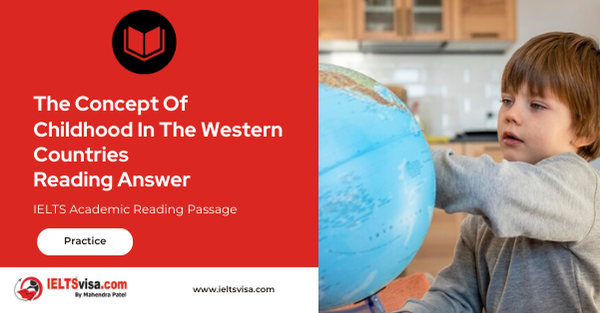The Concept Of Childhood In The Western Countries Reading Answer
IELTS Academic Reading Passage
The history of childhood has been a topic of interest in social history since the highly influential 1960 book Centuries of Childhood, written by French historian Philippe Ariès. He argued that “childhood” is a concept created by modern society.
A
One of the most hotly debated issues in the history of childhood has been whether childhood is itself a recent invention. The historian Philippe Aries argued that in Western Europe during the Middle Ages (up to about the end of the fifteenth century) children were regarded as miniature adults, with all the intellect and personality that this implies. He scrutinized medieval pictures and diaries, and found no distinction between children and adults as they shared similar leisure activities and often the same type of work. Aries, however, pointed out that this is not to suggest that children were neglected, forsaken or despised. The idea of childhood is not to be confused with affection for children; it corresponds to an awareness of the particular nature of childhood, that particular nature which distinguishes the child from the adult, even the young adult.
B
There is a long tradition of the children of the poor playing a functional role in contributing to the family income by working either inside or outside the home. In this sense children are seen as ‘useful’. Back in the Middle Ages, children as young as 5 or 6 did important chores for their parents and, from the sixteenth century, were often encouraged (or forced) to leave the family by the age of 9 or 10 to work as servants for wealthier families or to be apprenticed to a trade.
C
With industrialization in the eighteenth and nineteenth centuries, a new demand for child labour was created, and may children were forced to work for long hours, in mines, workshops and factories. Social reformers began to question whether labouring long hours from an early age would harm children’s growing bodies. They began to recognize the potential of carrying out systematic studies to monitor how far these early deprivations might be affecting children’s development.
D
Gradually, the concerns of the reformers began to impact on the working conditions of children. In Britain, the Factory Act of 1833 signified the beginning of legal protection of children from exploitation and was linked to the rise of schools for factory children. The worst forms of child exploitation were gradually eliminated, partly through factory reform but also through the influence of trade unions and economic changes during the nineteenth century which made some forms of child labour redundant. Childhood was increasingly seen as a time for play and education for all children, not just for a privileged minority. As the age for starting full-time work was delayed, so childhood was increasingly understood as a more extended phase of dependency, development and learning. Even so, work continued to play a significant, if less central role in children’s lives throughout the later nineteenth and twentieth century. And the ‘useful child’ has become a controversial image during the first decade of the twenty-first century especially in the context of global concern about large numbers of the world’s children engaged in child labour.
E
The Factory Act of 1833 established half-time schools which allowed children to work and attend school. But in the 1840s, a large proportion of children never went to school, and if they did, they left by the age of 10 or 11. The situation was very different by the end of the nineteenth century in Britain. The school became central to images of ‘a normal’ childhood.
F
Attending school was no longer a privilege and all children were expected to spend a significant part of their day in a classroom. By going to school, children’s lives were now separated from domestic life at home and from the adult world of work. School became an institution dedicated to shaping the minds, behavior and morals of the young. Education dominated the management of children’s waking hours, not just through the hours spent in classrooms but through ‘home’ work, the growth of ‘after school’ activities and the importance attached to ‘parental involvement.’
G
Industrialization, urbanization and mass schooling also set new challenges for those responsible for protecting children’s welfare, and promoting their learning. Increasingly, children were being treated as a group with distinctive needs and they were organized into groups according to their age. For example, teachers needed to know what to expect of children in their classrooms, what kinds of instruction were appropriate for different age groups and how best to assess children’s progress. They also wanted tools that could enable them to sort and select children according to their abilities and potential.
Questions 28-34
Do the following statement agree with the information given in Reading Passage 3?
Write your answers in boxes 28-34 on your answer sheet.
TRUE if the statement is true
FALSE if the statement is false
NOT GIVEN if the information is not given in the passage
28 Aries pointed out that children did different types of works as adults during the Middle Age. ——————
29 during the Middle Age, going to work necessarily means children were unloved indicated Aries. ————–
30 Scientists think that overworked labour damages the health of young children ———————-
31 the rise of trade union majorly contributed to the protection children from exploitation in 19th century. ———————
32 By the aid of half-time schools, most children went to school in the mid of 19 century. ——————–
33 In 20 century almost all children need to go to school in full time schedule. ——————–
34 Nowadays, children’s needs were much differentiated and categorised based on how old they are —————————
Questions 35-40
Answer the questions below.
Choose NO MORE THAN THREE WORDS from the passage for each answer.
Write your answers in boxes 35-40 on your answer sheet.
35 what is the controversial topic arises with the French historian Philippe Ariès’s concept. —————————-
36 what image for children did Aries believed to be like in Western Europe during the Middle Ages.——————–
37 what historical event generated the need for great amount child labour to work long time in 18 and 19 century ——————-
38 what legal format initiated the protection of children from exploitation in 19th centenary ————————-
39 what the activities were more and more regarded as being preferable for almost all children time in 19th centenary ———————————
40 where has been the central area for children to spend largely of their day as people’s expectation in modern society ——————————-

Solutions For:- The Concept Of Childhood In The Western Countries Reading Answer
28. FALSE
29. FALSE
30. TRUE
31. NOT GIVEN
32. FALSE
33. NOT GIVEN
34. TRUE
35. history of childhood
36. (as) miniature adults
37. (with the) industrialization
38. The factory
39. play and education
40. classroom
Review and Practice
- Regularly practice with IELTS reading samples and time yourself to get used to the pressure of the exam.
- Review your mistakes to understand where you went wrong and how to avoid similar errors in the future.
Our Books
Master IELTS Speaking Part 1
IELTS Writing Task 1 Book
IELTS Writing Task 2 Book
The Concept Of Childhood In The Western Countries Reading Answer Explanation
Comin Soon
Practice IELTS Other Modules
IELTS Listening
The IELTS Listening test assesses how well you can understand spoken English in various contexts. It lasts about 30 minutes and is divided into four sections with a total of 40 questions. The listening tasks become increasingly difficult as the test progresses.
IELTS Academic Reading
The IELTS Academic Reading section assesses your ability to understand and interpret a variety of texts in academic settings. It is designed to evaluate a range of reading skills, including skimming for gist, reading for main ideas, reading for detail, understanding inferences, and recognizing a writer's opinions and arguments.
IELTS Speaking
The IELTS Speaking test assesses your ability to communicate in English on everyday topics. It lasts 11-14 minutes and consists of three parts: introduction, cue card, and a discussion based on the cue card topic.
IELTS General Reading
IELTS General Reading tests your ability to understand and interpret various types of texts. Here are some key areas and types of content you can expect to encounter in the reading section, along with tips for effective preparation.
IELTS Academic Writing Task 1
In IELTS Academic Writing Task 1, you are presented with a visual representation of information, such as graphs, charts, tables, or diagrams, and you are required to summarize, compare, or explain the data in your own words.
IELTS General Writing Task 1
In IELTS General Writing Task 1, you are required to write a letter based on a given situation. The letter can be formal, semi-formal, or informal, depending on the prompt. Here’s a breakdown of the key components to include in your letter
IELTS Academic Writing Task 2
In IELTS Academic Writing Task 2, you are required to write an essay in response to a question or topic. Here’s a guide to help you understand the essential elements of this task
IELTS Exam Tips
To succeed in the IELTS exam, practice regularly, familiarize yourself with the test format, improve your vocabulary, develop time management skills, and take mock tests to build confidence.
Grammer for IELTS
Grammar is the foundation of effective communication in English. Understanding tense usage, subject-verb agreement, and sentence structure enhances clarity and coherence in writing and speaking.
Vocabulary for IELTS
Vocabulary plays a crucial role in the IELTS (International English Language Testing System) exam, especially in the Speaking and Writing sections. Here’s an overview of why vocabulary is important and how it impacts your performance
RECENT IELTS SAMPLES QUESTIONS AND ANSWERS
Becoming An Expert Reading Answer
A Expertise is commitment coupled with creativity. Specifically, it is the commitment of...
STUDY CENTRE COURSES Reading Answer
SELF-STUDY TIPS AHowever difficult you find it to arrange your time, it will pay off in the...
The Extrinct Grass In Britain Reading Answer
A The British grass interrupted brome was said to be extinct, just like the Dodo. Called...
Morse Code Reading Answer
A. A new satellite-based system is being implemented to replace Morse code for sending...
Magnetic Therapy Reading Answer
AMagnetic therapy, which is a $5-billion market worldwide, is a form of alternative medicine...
Lack Of Sleep Reading Answer
Section A It is estimated that the average man or woman needs between seven-and-a-half and...













